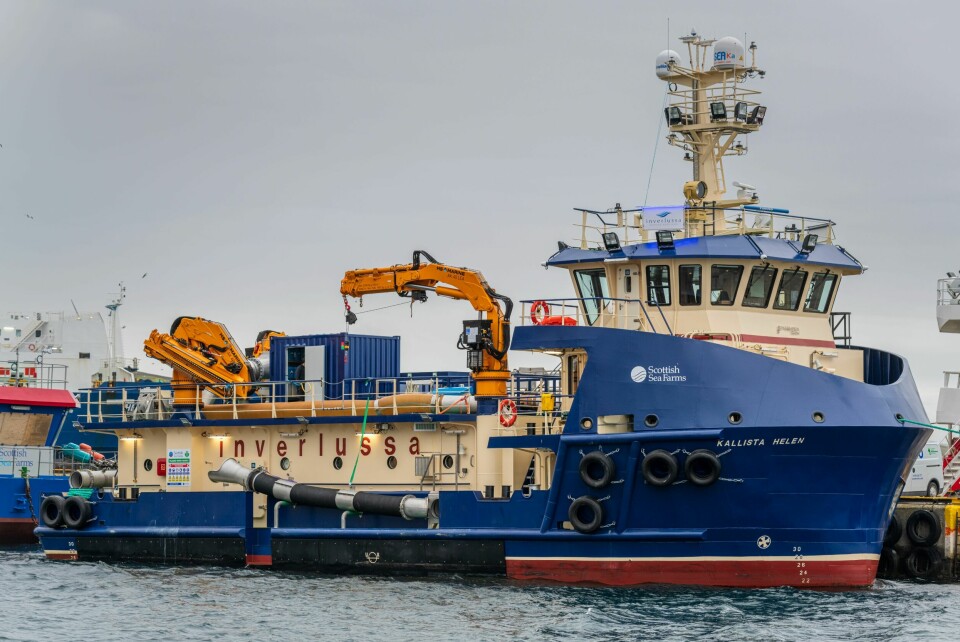
Scottish-built delousing vessel ready for action
A farmed salmon delousing vessel designed and built in Scotland is due to start work for Scottish Sea Farms before the end of the month following trials in Shetland.
The £6-million Kallista Helen was designed by Macduff Ship Design for Mull-based Inverlussa Marine Services, built by Ferguson Marine in Port Glasgow, and is equipped with a £2.5 million Thermolicer engineered by ScaleAQ in Norway in partnership with ScaleAQ UK and constructed in Scotland.
The 26-metre vessel, built with a focus on improved fish health and welfare, was inspected during the commissioning stage by the RSPCA.
Tailored to system
“This is the first vessel where we’ve built the boat to suit the system rather than building the system to suit the boat,” SSF’s Shetland area support manager Robbie Coutts told the company’s newsletter, The Source.
“From start to finish, we’ve had total input – led by Scottish Sea Farms engineering and project manager for Shetland Keith Fraser – on where everything should be and we’re feeling the benefits of it now.”
Those benefits include a “shelterdeck” which protects the equipment and offers greater seaworthiness and crew safety.
“This means we can be where we want to be and implement sea lice control earlier,” said Coutts. “We’re coming into the time of year when it becomes very tricky to plan anything because of the weather but with this boat we can close the doors on the shelterdeck and clean the machine on our way to the next job.”
Three cranes
The extra deck space also makes the Kallista Helen self-sufficient, able to carry out pen-side tasks with her own cranes rather than depending on other workboats.
Fish welfare improvements include a wider, 600mm diameter pipe for bringing fish aboard. This is gentler on the fish and also facilitates throughputs of 120 tonnes an hour.
Installation of the Thermolicer was carried out at Morrison Dock in Lerwick by ScaleAQ and Shetland-based marine engineering and electrical contractor Ocean Kinetics.

Highly effective
John Henderson, managing director of Ocean Kinetics, said: “We were delighted to have the opportunity to work with ScaleAQ on the design and manufacture of key elements of the Thermolicer for Scottish Sea Farms, and are really pleased with how the project has gone. It is now fully tested, and the system has proved to be very efficient and highly effective.
“The pipework has been constructed for a swift and smooth journey for the fish, and a sophisticated filtration and separation system ensures that the sea lice are not released back into the marine environment.”
He added: “This is the most recent in a series of projects we have undertaken for Scottish Sea Farms in Shetland over the last while. We have carried out a number of upgrades to vessels in order to maintain the highest levels of animal husbandry, all of which contributes to the continued smooth and efficient running of the company’s Shetland operation.”
Other systems
Ocean Kinetics installed a three-line high-capacity de-lousing system onboard Inverlussa’s 28-metre multi-purpose service vessel Helen Mary, built by Macduff. The design and manufacturing team worked closely with SSF on the dewatering tanks, chutes and suction system, all of which were optimised to ensure gentle treatment of the fish while maximising throughput.
The complete system has also been designed for minimal down time between cage set ups.
The company also worked for ScaleAQ on the build and installation of a treatment system on board Inverlussa’s 27-metre Helen Burnie, also built by Macduff Shipyards and on lease to SSF.
Ocean Kinetics also carried out improvements to the Hydrolicer system onboard Delta Marine’s multipurpose workboat Voe Viking. These included alterations to the water separator, fabricating and fitting new chutes and platforms, and alterations to pipework.






















































